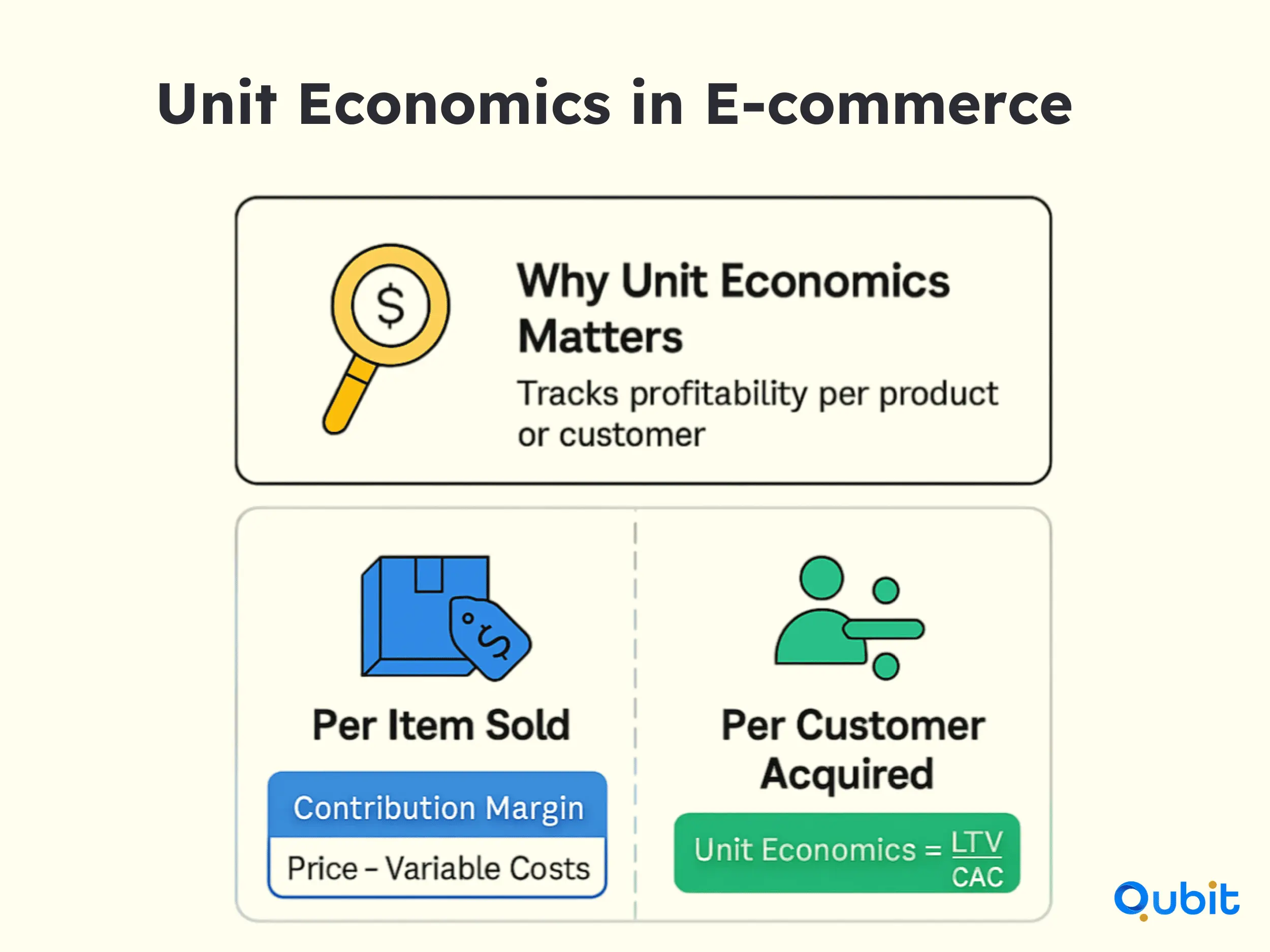Investor confidence often hinges on demonstrating a solid grasp of unit economics and financial modeling. These elements are the backbone of profitability for e-commerce startups, offering insights into cost structures, revenue streams, and scalability potential. Without a clear understanding of these metrics, businesses risk losing out on critical funding opportunities.
This blog will explore how mastering unit economics can help you identify profitable growth strategies, while a robust financial model ensures your business remains sustainable and attractive to investors. From calculating customer acquisition costs to forecasting long-term profitability, we’ll cover the essentials to help you build a compelling case for your e-commerce venture.
Let’s jump right in!
Understanding Unit Economics: Definitions and Breakdown
Unit economics examines the financial performance of a single unit within a business, revealing the relationship between revenue and costs. This concept is vital across industries, as it helps businesses evaluate profitability and scalability. Key components include pricing strategies, supply chain efficiency, and marketing effectiveness, all of which contribute to accurate financial modeling.
For instance, airlines define a unit as one seat sold, showcasing how unit economics applies to seat sales and operational metrics. To explore how inventory metrics can connect to per-unit cost analysis for e-commerce businesses, visit inventory metrics ecommerce investors.
Why Unit Economics Matters
Unit economics plays a pivotal role in shaping a business’s financial strategy. By analyzing the profitability of individual units, whether products, services, or customers—companies gain a clearer understanding of their financial health. This granular approach helps forecast profits and refine product offerings, ensuring that scaling efforts remain sustainable.
As businesses increasingly rely on unit economics analysis, optimizing pricing and products becomes essential for long-term success. This trend highlights the growing importance of thorough financial modeling, particularly in industries like e-commerce.

Calculation and Analysis of Unit Economics
This section introduces two primary approaches to calculating unit economics, each tailored to different business models.
Defining the Unit as One Item Sold
When the unit is defined as a single item sold, the focus shifts to contribution margins. The formula for calculating this is straightforward: Contribution margin = price per unit – variable costs per sale. By tracking variable costs and revenue per unit, businesses can determine how much profit each item contributes after covering direct expenses. This metric is particularly useful for product-based businesses aiming to optimize pricing strategies and cost structures.
Defining the Unit as One Customer
Alternatively, businesses can define the unit as one customer, emphasizing the LTV/CAC ratio. This equation, UE = LTV/CAC, compares the lifetime value (LTV) of a customer to the cost of acquiring them (CAC). A higher ratio indicates a more sustainable and profitable customer acquisition strategy. This approach is ideal for subscription-based or service-oriented businesses where customer retention drives profitability.
For a deeper dive into benchmarks for LTV/CAC ratios, explore the ecommerce LTV CAC benchmarks 2025 for actionable insights tailored to seed rounds.
Modeling Customer Lifetime Value
Understanding customer lifetime value (LTV) is essential for businesses aiming to optimize their revenue strategies. Two distinct methodologies—Predictive LTV and Flexible LTV—offer unique approaches to calculating this metric. Predictive LTV relies on historical data and statistical models to forecast future customer behavior, while Flexible LTV adjusts dynamically to reflect real-time changes in revenue streams. Key metrics such as average order value, gross margin, churn rate, and retention rate play a pivotal role in both approaches. By combining these metrics with tailored formulas, businesses can gain a comprehensive view of LTV, enabling informed decisions that drive sustainable growth.
Analyzing Customer Acquisition Cost
Customer Acquisition Cost (CAC) is calculated by dividing total sales and marketing expenses by the number of customers acquired during a specific period. This metric is essential for assessing the efficiency of marketing efforts and understanding cost structures. Equally important is the LTV:CAC ratio, which compares the lifetime value (LTV) of a customer to the cost of acquiring them. A healthy ratio indicates sustainable and scalable acquisition strategies, ensuring long-term business growth. Tracking these metrics helps businesses optimize marketing performance and maintain financial health.
Learn More About Business and Economics
Expanding your knowledge of business and economics can unlock new opportunities for growth. This section encourages readers to explore resources that delve into the fundamentals of unit economics and their role in strategic funding decisions. For example, understanding ecommerce startup fundraising strategies can provide a solid foundation for connecting diverse investment avenues to your overall financial approach.
Discounting versus Value-Adding
Excessive discounting can undermine profitability and dilute brand perception. While discounts may attract short-term sales, they often erode profit margins and set unrealistic pricing expectations among customers. On the other hand, value-based pricing strategies focus on enhancing the product or service, fostering customer loyalty and improving long-term profitability.
Shift from discounting to value-adding pricing strategies trend, brands that prioritize value addition safeguard margins and strengthen brand equity. Heavy discounting risks lower lifetime value (LTV) and diluted brand perception, making sustainable pricing strategies a smarter choice.
For insights on integrating pricing strategies into broader business plans, explore our guide on ecommerce go to market plan fundraising.
An Example
Discounting can severely impact profitability, as illustrated by Adam’s Robes Co LLC. When the company applied a 20% discount, robe profits plummeted from $15 to just $3 per unit. To offset this loss, they needed a staggering 500% increase in sales volume to break even.
Alternatively, a value-added strategy, enhancing product appeal without slashing prices—proved far more effective. This example underscores the risks of deep discounting and highlights the sustainability of approaches that prioritize added value over price cuts.
Understanding Unit Economics for Email Marketing Strategists
Unit economics offers a powerful lens for refining email marketing strategies. By analyzing the financial metrics tied to individual customer acquisition and retention, marketers can craft campaigns that maximize profitability. For instance, understanding customer acquisition costs (CAC) enables the creation of highly targeted email campaigns that focus on high-value segments.
Integrating unit economics into email marketing fosters data-driven decision-making, ensuring campaigns are not only effective but also cost-efficient. This approach transforms marketing communications into a strategic tool for sustainable growth.
Expertise in Email Marketing and Unit Economics
Mastering email marketing while aligning it with unit economics can transform campaign outcomes and profitability. Advanced tools like the Klaviyo Health Audit provide actionable insights to refine email strategies and optimize financial performance.
This integration ensures campaigns not only resonate with audiences but also support sustainable growth. By combining specialized expertise with strategic partnerships, businesses gain a competitive edge in marketing execution and financial modeling.
Conclusion
Mastering unit economics and crafting a robust financial model are essential steps for any business aiming for sustainable growth. Throughout this blog, we’ve explored strategies to optimize these metrics, emphasizing their role in attracting investors and ensuring long-term profitability. By focusing on actionable insights, businesses can transform theoretical knowledge into practical improvements that drive results.
If you're ready to elevate your unit economics and secure the right investors, we at Qubit Capital are here to assist. Our Investor Outreach service is designed to help you connect with investors who align with your vision. Reach out to us today to start your journey toward financial excellence.
Key Takeaways
- Understanding unit economics is crucial for gauging profitability in e-commerce.
- Accurate analysis involves both item-level and customer-level metrics.
- Advanced approaches like predictive and flexible LTV models can refine financial planning.
- Value-based pricing is a more sustainable alternative to heavy discounting.
- Integrating unit economics with targeted email marketing enhances investor readiness.
Frequently asked Questions
What is unit economics in ecommerce?
Unit economics in ecommerce examines the cost and revenue associated with a single unit, whether that unit is a product or a customer. This metric provides a clear understanding of profitability at the most granular level.


 Back
Back



